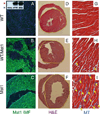Injection of wild type embryonic stem cells into Mst1 transgenic blastocysts prevents adult-onset cardiomyopathy
- PMID: 21086068
- PMCID: PMC3244830
- DOI: 10.1007/s12015-010-9206-6
Injection of wild type embryonic stem cells into Mst1 transgenic blastocysts prevents adult-onset cardiomyopathy
Abstract
Embryonic stem cells have the capacity to differentiate into a wide range of cell types. We previously described that blastocyst injection of wild type (WT) embryonic stem cells (ESCs) into various knockout (KO) mouse models of human disease prevents disease from occurring. In this study we ask if the blastocyst approach can also correct defects in a mouse model of transgenic (Tg) overexpression of a pro-apoptotic factor. We injected ROSA26 (LacZ-marked) WT ESCs into human mammalian sterile 20 like-kinase 1 (Mst1) Tg blastocysts. Mst1 Tg mice overexpress Mst1, a pro-apoptotic factor, in a cardiac-specific manner. As a result, Mst1 Tg mice develop adult dilated cardiomyopathy driven by apoptosis, reduction in cell density and no hypertrophic compensation. Incorporation of WT ESCs generated WT/Mst1 chimeric mice with normal hearts at histological and functional levels. Accordingly, apoptosis and cell density parameters were normalized. The experiments suggest that an adult-onset cardiac myopathy induced by overexpression of the pro-apoptotic Mst1 can be reversed by developmental incorporation of WT ESCs. The findings also suggest that since forced expression of the Mst1 transgene is not abolished in the rescued chimeras, the WT ES-derived cells normalize pathways that lie downstream of Mst1. The results expand the therapeutic capability of the ESCs to mouse models that overproduce detrimental proteins.
Conflict of interest statement
Figures

Similar articles
-
Mst1 inhibition rescues β1-adrenergic cardiomyopathy by reducing myocyte necrosis and non-myocyte apoptosis rather than myocyte apoptosis.Basic Res Cardiol. 2015 Mar;110(2):7. doi: 10.1007/s00395-015-0461-1. Epub 2015 Jan 20. Basic Res Cardiol. 2015. PMID: 25600225 Free PMC article.
-
Activation of Mst1 causes dilated cardiomyopathy by stimulating apoptosis without compensatory ventricular myocyte hypertrophy.J Clin Invest. 2003 May;111(10):1463-74. doi: 10.1172/JCI17459. J Clin Invest. 2003. PMID: 12750396 Free PMC article.
-
Exosomal Mst1 transfer from cardiac microvascular endothelial cells to cardiomyocytes deteriorates diabetic cardiomyopathy.Biochim Biophys Acta Mol Basis Dis. 2018 Nov;1864(11):3639-3649. doi: 10.1016/j.bbadis.2018.08.026. Epub 2018 Aug 22. Biochim Biophys Acta Mol Basis Dis. 2018. PMID: 30251683
-
Galectin-3 deficiency ameliorates fibrosis and remodeling in dilated cardiomyopathy mice with enhanced Mst1 signaling.Am J Physiol Heart Circ Physiol. 2019 Jan 1;316(1):H45-H60. doi: 10.1152/ajpheart.00609.2018. Epub 2018 Nov 2. Am J Physiol Heart Circ Physiol. 2019. PMID: 30387702
-
Blastocyst injection of embryonic stem cells: a simple approach to unveil mechanisms of corrections in mouse models of human disease.Stem Cell Rev Rep. 2009 Dec;5(4):369-77. doi: 10.1007/s12015-009-9089-6. Epub 2009 Aug 25. Stem Cell Rev Rep. 2009. PMID: 19705303 Review.
Cited by
-
Interspecies Organogenesis for Human Transplantation.Cell Transplant. 2019 Sep-Oct;28(9-10):1091-1105. doi: 10.1177/0963689719845351. Epub 2019 Aug 19. Cell Transplant. 2019. PMID: 31426664 Free PMC article. Review.
-
Functional role of Mst1/Mst2 in embryonic stem cell differentiation.PLoS One. 2013 Nov 5;8(11):e79867. doi: 10.1371/journal.pone.0079867. eCollection 2013. PLoS One. 2013. PMID: 24224013 Free PMC article.
References
-
- Schneider JS, Vitale JM, Terzic A, Fraidenraich D. Blastocyst injection of embryonic stem cells: a simple approach to unveil mechanisms of corrections in mouse models of human disease. Stem Cell Reviews and Reports. 2009;5(4):369–377. - PubMed
-
- Fraidenraich D, Benezra R. Embryonic stem cells prevent developmental cardiac defects in mice. Nature Clinical Practice. Cardiovascular Medicine. 2006;3 Suppl 1:S14–S17. - PubMed
-
- Chien KR, Moretti A, Laugwitz KL. Development. ES cells to the rescue. Science. 2004;306(5694):239–240. - PubMed
Publication types
MeSH terms
Substances
Grants and funding
LinkOut - more resources
Full Text Sources
Medical
Research Materials
Miscellaneous

